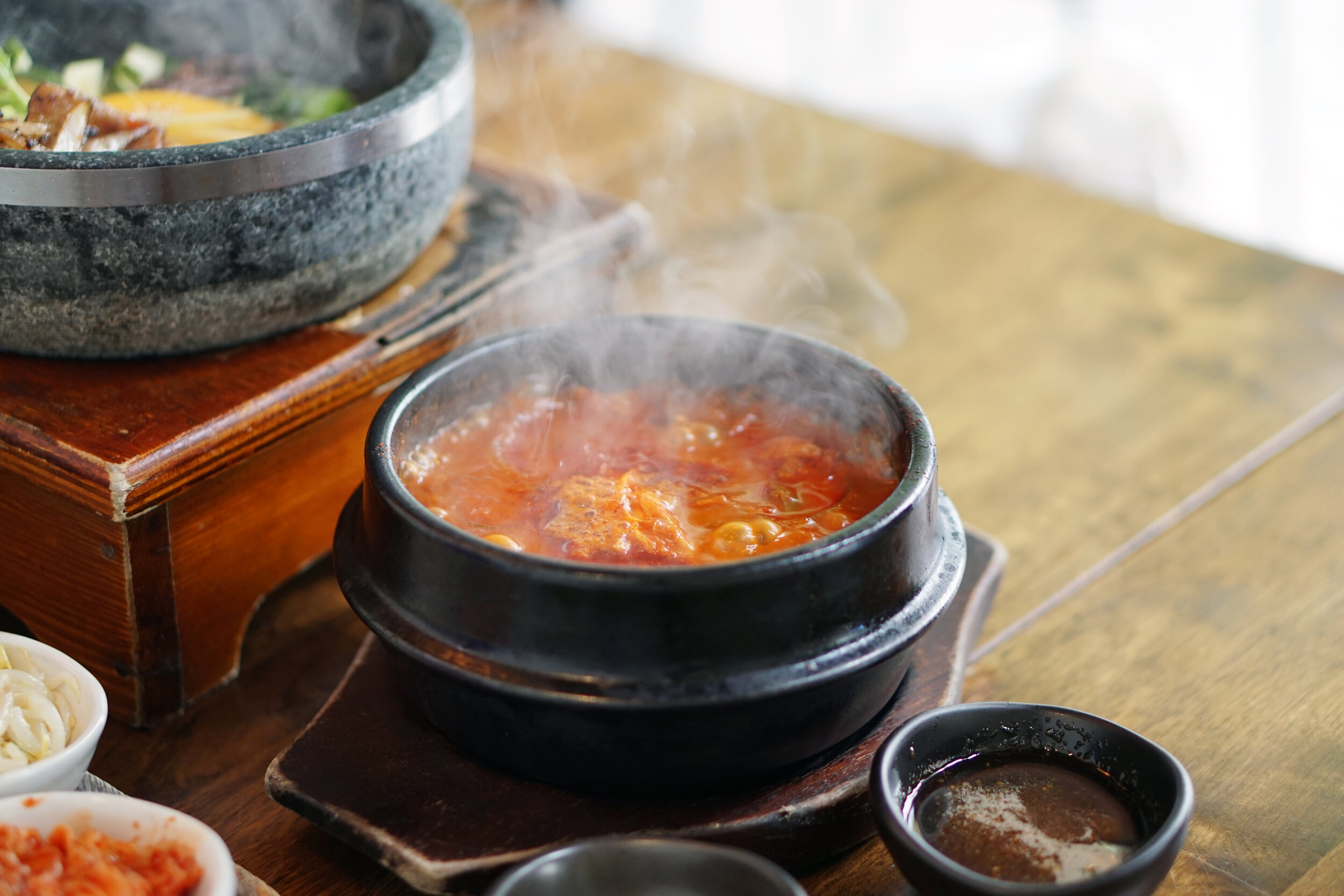16 Best Vegan Korean Foods
Korean food is a staple cuisine here in Los Angeles and anywhere around the world.
Ranging from delicious meats served from Korean BBQ to creative and tasty vegetable dishes that can make anyone excited to eat.
As a Korean American and someone who has been eating Korean food all my life, I devised a list of all my favorite Korean food dishes that are usually served vegan and, best of all, pack a ridiculous amount of flavor and tradition
It can be hard to find vegan dishes in many Asian cuisines so we conjured up a list that portrays our favorite vegan dishes ranked from what we believe is the most delicious and healthy.
In this article we will also be going over the nutrition facts and what goes inside each dish so we can make sure that there are only plant based ingredients. Let’s get into this!
16. Miyuk Gook
Miyuk Gook is a very traditional Korean dish that is eaten for an individuals birthday or when a woman is pregnant with a baby.
It’s a delicious soup that is super simple and requires five ingredients, seaweed, water, garlic, sesame oil, and soy sauce. Before you say anything about how simple it is, make sure you give it a try and appreciate the savory flavors you get from the combination of sesame oil, garlic, and soy sauce. Let’s look at the calorie content and macronutrient ratios for this soup.
Here are the nutrition facts for Miyuk Gook below
For every bowl served there is 1 gram of fat, 5 grams of carbs, and no protein.
Miyuk gook is great for anyone looking to shed fat since there are barely any calories and is very saitiating.
Miyuk gook is usually served as a side dish so you can even eat this with as an addition to another dish.
15. Kongnamul Gook
Kongnamul Gook or beansprout soup is also a very traditional dish that is usually served as an appetizer or an addition to a dish.
What’s great about this dish is that it is very savory and has an awesome flavor that can be adjusted by adding chilis and garlic.
It’s a very simple dish so it can take many different routes when served.
I’ve had this dish served super spicy, with mushrooms, or even with lime. Here are the nutrition facts down below
For every bowl served there are 4 grams of fat, 2 grams of carbs, and 1 gram of protein.
This is great as, once again, there are very little calories per bowl served and is very satiating and satisfying.
Korean like to enjoy this with a lot of other meat dishes but if you’re trying to stick with your vegan diet or lifestyle then just pair it with one of the foods on this list!
14. Kimchi Jjigae
There is so much to be said about Kimchi Jjigae as it is one of the most popular comfort foods that Koreans enjoy to eat.
There is a lot of nostalgia for someone who was raised off of Korean foods so this dish is something you have to try if you haven’t had it.
It has a spicy, savory flavor and can be served with a variety of different vegetables and fibers such as green onions, leeks, or even potatoes.
The reason why it’s so high on this list, however, is because it is very hard to find a vegan version of this food as many Kimchi Jjigaes are served with either spam or beef.
Sounds gross but it’s actually pretty good.
Check out this link for a recipe on how to make Vegan Kimchi Jjigae. https://www.connoisseurusveg.com/kimchi-stew-with-tofu-and-shiitakes/
Let’s take a look at the calories listed above. For every bowl served there are 6 grams of carbs, 12 grams of carbs, and 6 grams of protein.
Pretty amazing for such a hard and delicious soup.
Koreans love to eat this with rice but be careful with the amount of calories you can consume, this stuff is addicting!
13. Tteok
Tteok or Korean Rice Cakes are another traditional food that Koreans like to enjoy during the new year.
Tteok is a sweet, chewy cake made out of rice flour and water and comes in a wide variety of choices.
The tip here is to make sure to stick with the basic tteok or make it yourself to be sure that it’s vegan. There are a lot of tteok dishes out there that have a custard made from eggs so, to be safe, the simpler the better.
Let’s check out the calories of a typical tteok dish.
A serving size of 8 ounces runs for 1 gram of fat, 50 grams of carbs, and 5 grams of protein.
The reason why this is a little high on this list is because it is a little high on carbs and can be easy to overeat.
Remember, carbs aren’t the enemy. Eating over your calories limit is when the fat starts to accumulate!
12. Kimchi Fried Rice
Kimchi Fried Rice is, in my opinion, the best type of fried rice that you can get out of all the Asian dishes out there.
I know it’s a bold statement but there is something that is so special about this type of fried rice.
There’s spicy, savory, and, sometimes, sweet flavors that can come from a Kimchi Fried Rice dish which is something that you can’t really get from other fried rice dishes.
They just don’t compare. Let’s look at the calorie range for a typical kimchi fried rice
For every cup of fried rice served there are 9 grams of fat, 35 grams of carbs, and 9 grams of protein.
Pretty standard macros for a fried rice dish but, just like the other higher carb options on this list, there is a high potential to overeat this dish and I don’t blame you.
Our tip here is to just make sure how many calories you need to eat in a day and to track your food.
11. Hotteok
Hotteok is a Korean pancake that is stuffed with melted brown sugar and almonds or some other kind of diced nut.
This pancake is usually enjoyed on the streets or at some restaurants here in Los Angeles.
It’s honestly really hard to find these but, if you want to buy it from the store, there are many vegan options that you can find and cook up at home.
Let’s take a look at the calories.
For every 9 grams of fat there are 30 grams of carbs and 4 gram of protein. Not bad considering that this is a desert option.
These pancakes are delicious and they’re amazing when you actually have them in Korea.
However, make sure that they’re not frying the pancakes in animal fats as that is also something that tradition dictates.
10. Zucchini Pancakes
The Zucchini Pancake is a fried pancake that is stuffed with Zucchinis and served with a garlic and soy based sauce. It’s usually served as an appetizer but you can definitely have it as a meal if you’d like.
This is one of my favorite dishes when I go out to eat at my favorite Korean restaurants and, the crazy part is, these are sometimes even served complimentary as the Banchan (side dishes) that come with the meal.
They’re crunchy, crispy, and chewy while having an awesome garlic and zucchini flavor.
Although it’s delicious, let’s look at the calorie contents and what goes into a typical Zucchini Pancake.
For every 4 grams of fat there are 14 grams of carbs and 8 grams of protein.
This is great as they’re low in calories and are really filling and satisfying to eat.
There are 3 grams of fiber within these pancakes since they are stuffed with veggies. Great option for any diet and fitness goal.
9. Kimchi Zucchini Pancakes
If you’re a fan of kimchi and spicier foods then this is definitely the pancake for you.
Not to bash on the regular Zucchini Pancakes, but, I have to say, the Kimchi Zucchini Pancakes definitely win when the two are put face to face.
Along with the garlic and zucchini flavors that you get from this dish, you get an awesome spicy and acidic taste from the Kimchi’s flavor profile.
If there is an option to get the Kimchi version of these pancakes, I say, go for it! Let’s take a look at the calories for one of these pancakes.
For every 4 grams of fat there are 17 grams of carbs and 8 grams of protein.
Pretty similar to the pancakes listed above and, just like the Zucchini Pancakes, these are great to eat for an actual meal.
Try it out and you won't be disappointed!
8. Kimchi
If you know Korean food or even Asian food in general then you’ve heard of the almighty Kimchi.
Kimchi is a cabbage dish that is marinated in Korean chili powder, garlic, and sometimes sugar. It is then fermented and carries a ton of amazing flavors that has become famous worldwide.
However, watch out for many Kimchis out there because it can also be marinated with clams or shrimp to provide some extra umami to the flavor.
Most Kimchis are labeled as either vegan or not vegan so it’ll be pretty easy to find if you’re at a Korean supermarket. Here are the nutritional contents of a typical Kimchi.
This is an awesome food as there are hardly any calories and it is packed with fibers.
For every 1 gram of fat consumed there are 4 grams of carbs and 2 grams of protein.
Pretty awesome ratio and amazing for so many types of dishes out there. Definitely give Kimchi a try if you haven’t already!
7. Tofu Kimbap
Kimbap is another amazing dish that is a staple food in Korea.
This dish, however, is usually served with beef, chicken, or fish cakes called odeng.
Our recommendation is to buy these at a local supermarket or to make them yourself as most places don't have a vegan option for these rolls.
It is rare to find these with tofu inside of them so be sure to watch out when eating this. Here are the nutrition facts down below.
For every 1 gram of fat, there are 22 grams of carbs and 4 grams of protein.
Not bad at all for a couple of bites and great for anyone looking for a sushi-like vegan roll.
6. Japchae
Japchae is usually served in a variety of different appetizers that’s called Banchan.
Banchan is a glass noodle dish that is made from potato starch and is stir fried in soy sauce, brown sugar, vegetable oil and sesame oil.
It’s a very delicious dish and is served at almost every single Korean restaurant that you find out there.
You can also make it yourself and top it off with whatever veggies you love to eat!
Koreans usually like to put mushroom, carrots, and grilled onions on top of it to garnish but you can put whatever vegetables you see fit. Here are the nutrition facts for a typical Japchae plate.
For every 9 grams of fat, you consume 32 grams of carbs and 12 grams of protein.
Not bad at all since you usually just eat a little bit of this dish as an appetizer or to compliment your meal.
There are also 4 grams of fiber in this which usually comes from the large variety of veggies.
5. Green Onion Pancake
The green onion pancake is a very hardy Korean dish and is definitely a comfort food that Koreans eat during BBQ or with soup.
Green Onion Pancakes are usually served with seafood such as squid or octopus but there are many different vegetarian and vegan options that are usually on the menu as well.
Let’s take a look at the nutrition facts.
For every 8 grams of fat, there are 44 grams of carbs and 7 grams of protein.
A little high on the carbs for this meal so just watch out on overeating this dish.
4. Doenjang Jjigae
Doenjang Jjigae is honestly my favorite Korean stew as it has such a deep savory flavor that comes from the fermented soy beans that makes the base of the soup.
What makes this dish so awesome, however, is the tofu that it’s served with.
Tofu loves to soak up the broth of any soup and, when poured into Doenjang Jjigae, it takes on an awesome flavor and keeps it’s texture light and soft.
There are also a ton of great vegetables that go into a typical Doenjang Jjigae such as zucchini, mushrooms, enoki mushrooms, boiled radish, and different types of chilis. Let’s take a look at the nutrition facts.
For every 8 grams of fat there are 7 grams of carbs and 14 grams of protein.
There are not many vegan options where the protein is higher than the amount of carbs so this is definitely a staple food for anyone looking to get their protein in while eating a plant based diet.
3. Naengmyeon Noodles
Naengmyeon noodles are rice noodles that are served cold and swim in a vinegar based sauce with chilis and some sugar.
The traditional way to make these noodles, however, are to add beef broth to the stock but a simple vegetable broth can do just fine in this dish.
It’s usually very hard to find a vegan Naengmyeon dish at a restaurant, so finding a vegan recipe will be your best option for this dish.
The real star of this dish is not the beef broth anyway.
The real star of this dish comes from the acidic taste of the vinegar base and the crunch Korean radishes that garnish the dish. Let’s look at the nutrition facts.
For every 3 grams of fat there are 88 grams of carbs and 9 grams of protein.
A little high on the carbs so make sure you eat this in moderation.
We definitely recommend having this a cheat meal or a weekend snack that you can eat without guilt.
2. Hobak Juk
Hobak Juk is a dish that’s special to me since my mother always knew this was my favorite Korean dessert and she would always make it for me after I came back from school.
It’s a dish that is filled with nostalgia and is something that everybody should try at least once in their lives.
It’s basically a thick chowder made from pumpkins and is seasoned with honey, salt, and a little bit of sweet rice flour.
There are tiny balls of tteok that swim around the dish and add a chewy bite within every single spoonful of this soup you get.
Let’s look at the nutrition facts.
For every 10 grams of fat, there are 18 grams of carbs and 5 grams of protein.
Not bad at all for such a hardy dish!
The reason why you can feel so full after eating a bowl of this is due to the massive amount of fiber that you get from the pumpkin.
You have to try out this dish if you love pumpkin soup.
1. Kong Guksu
The number one slot for the best Vegan Korean food has to go to Kong Guksu.
This dish is very labor intensive as it requires you to soak soybeans for two whole days before grinding up with water, toasted sesame seeds, and pine seeds.
The result, however, is a very thick and delicious soup that is savory and rich. Rice noodles are then added to the soup and are served cold with ice cubes or just refrigerated.
These noodles soak up the broth really well and I could compare the dish to a healthier cream based pasta except soaked in soybeans and refreshing instead of heavy.
It’s an amazing dish and is something that everyone should try if they’re interested in Korean food in general. Let’s take a look at the calories one last time and see what goes into these amazing noodles.
For every 9 grams of fat there are 14 grams of carbs and 17 grams of protein.
These noodles contain the highest amount of protein per serving and is also why it earns the number one spot on this list.
Not only is this the most delicious option on the list, but it is also the healthiest in terms of weight loss and keeping fit.
Kong Guksu is a powerhouse of a food and, thus, is an amazing option to just eat in general.
There it is
16 amazing vegan foods that are healthy and great for any diet.
Make sure to check out our other blogs for healthier Asian food dishes and tips on how to look and feel great!
RECENT POSTS
The Asian Weight Loss Cookbook
The 15 Fat Burning Meals Cookbook features our favorite recipes that you can use to get closer to your fitness goals.
Become your own personal trainer with the guidance of this book and make this the year you achieve your insurmountable fitness goals.
phillip pak
Phillip Pak is a fitness expert who has been training clients for 6 years. Throughout his fitness journey, Phill has done it all when it comes to diet and nutrition. He is now the owner of Aspire Fitness Walnut where his main goal is to help those who are seeking to find the best version of themselves. Phillip is also a NASM Certified Nutrition Coach (CNC) and a NASM Certified Personal Trainer (CPT).










































